"ONI Publications, WWI" ZV file, Navy Department Library.

The Navy Department Library
Analysis of the Advantage of Speed and Changes of Course in Avoiding Attack by Submarine
O.N.I. Publication No. 30
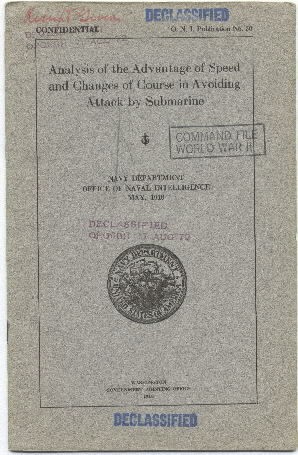
O. N. I. Publication No. 30
[formerly] CONFIDENTIAL [Declassified 17 Aug 72]
Analysis of the Advantage of Speed
and Changes of Course in Avoiding
Attack by Submarine
NAVY DEPARTMENT
OFFICE OF NAVAL INTELLIGENCE
MAY, 1918
WASHINGTON
GOVERNMENT PRINTING OFFICE
1918
--- 2 --- (blank).
OFFICE OF NAVAL INTELLIGENCE
May 1, 1918.
This pamphlet contains information regarding the advantage of speed and changes of course in avoiding attack by submarines, compiled by Commander W. S. Pye, United States Navy. It is very important that this information should be kept confidential, and no person below the rank of a commissioned officer is to be allowed to examine it except by permission of the commanding officer, in the case of persons in the Navy who may require knowledge of its content, in the performance of their duties.
ROGER WELLES,
Captain, United States Navy,
Director of Naval Intelligence.
--- 3 ---
--- 4 --- (blank).
ANALYSIS OF THE ADVANTAGE OF SPEED AND CHANGES OF COURSE IN AVOIDING ATTACK BY SUBMARINE.
1. It has been generally recognized that high speed and frequent changes of course by vessels within the War Zone are desirable; this analysis has been undertaken with a view to indicating the relative value of speeds and the most advantageous amounts and frequency of changes of course in avoiding torpedoes fired from submarines.
2. The value of speed for this purpose can be demonstrated mathematically or graphically and is indisputable. The value of changes of course can not be proven mathematically and such is therefore dependent on conclusions drawn from an analysis of the operation of the enemy submarines previous to and during an attack.
ANALYSIS OF THE VALUE OF SPEED IN AVOIDING SUBMARINE ATTACK.
3. The first factor to be considered is the number of hours of daylight, or moonlight, spent in the submarine danger zone, and it may be said without question that this number should be reduced to the smallest possible amount consistent with obtaining the most advantageous conditions. This will be accomplished by arriving within safe waters as near daylight as possible and by using maximum speed on the straightest course. Special conditions may in cases make it inadvisable to arrive off a port at daylight; i.e., when submarines are known to be concentrated near shore. The principle stated above assumes a uniform density of submarines in the so-called "War Zone," an assumption which information may make untenable.
4. The greatest amount of submarine activity today is close to shore and in location where the convoy system is difficult of execution. The procedure should, therefore, be modified so that vessels shall arrive in this zone, after daylight. The analysis of the value of speed and zigzag courses should first be made from the point of view of a vessel acting singly.
5. The effect of speed is great in reducing the time within the danger zone, but even greater in reducing the chance of being attacked by submarines even if the vessel is seen.
6. It is assumed that a submarine cruising on the surface may sight a vessel at a maximum distance of 10 miles while she herself
--- 5 ---
may not be sighted at more than 5 miles. Of course, smoke may be sighted at a greater distance, but generally speaking the circle of visibility of a low-lying submarine may be taken as having a radius of 10 miles.
7. The maximum surface speed of a submarine is, in this analysis, assumed to be 16 knots and the submerged speed to be 8 knots. The average speed of enemy submarines is probably somewhat less, and submarines having a 10 or 12 knot submerged speed are probably rare. This maximum submerged speed can not in many cases be maintained for a longer period than two hours.
8. In order that torpedoes may be fired with a high degree of probability of hitting, it is assumed that the submarine will not wish to fire her torpedoes at a target at a greater distance than 1,000 yards.
9. As stated above, it is not meant that there may not be frequent departures from some of these assumptions, but deductions based on these assumptions should not be less valuable if these assumptions represent approximately average conditions.
10. In delivering its attack, the task of the submarine is to reach, undetected, a circle (approximately) of a radius of 1,000 yards, having the vessel at its center, and, conversely, the task of the vessel is to keep the submarine out of such circle and as far out of it as possible. The present analysis does not concern itself with the fact that certain parts of this circle are less favorable than other parts for successfully torpedoing a vessel at its center, but only with the task of the vessel in reducing to a minimum by the use of speed the chances of a submarine reaching any point within 1,000 yards of the vessel. Herein the term "successful attack" means that a submarine has reached any point 1,000 yards from the vessel attacked.
11. Referring to Figure I, area A is the area which the submarine desires to reach to fire her torpedo. This area has the ship attacked at its center and a radius of 1,000 yards. To reach area A, the submarine, to avoid detection, must submerge outside of area B, a circle of 5 miles radius. In area C (a circle of 10 miles radius) the submarine may run on the surface undetected and still have the object of her attack in sight, while a submarine outside of area C can not detect a vessel at the center of area A. These areas move with the ship occupying any particular position on the surface of the sea only momentarily.
12. The submerged speed of the submarine being 8 knots, it is apparent that a vessel of a speed less than 8 knots may be successfully attacked from any part of areas C and B, whatever the course steered by the ship may be, provided the submerged radius of action of the submarine is adequate. In practice this limitation of submerged endurance reduces the arc from which a submarine may deliver its attack. Of course, an attack from astern is not to be desired by the
--- 6 ---
submarine, since her rate of approach could not exceed the difference between her speed and that of the vessel attacked, and thus she would run a much greater risk of detection by being in sight for a longer time. If it were not for the limited submerged radius of action a successful attack could be made from any bearing so long as the submarine had any superiority of speed, and nothing could be done by the speed of the vessel to prevent it. The distance from the ship at which the submarine may be able to make a successful attack is, on some bearings, limited by the small submerged radius of action.
![Figure I [showing areas A, B, and C. A is 2,000 yards in diameter; B is 10 miles in diameter; and C is 20 miles in diameter]. Figure I [showing areas A, B, and C. A is 2,000 yards in diameter; B is 10 miles in diameter; and C is 20 miles in diameter].](/content/history/nhhc/research/library/online-reading-room/title-list-alphabetically/a/analysis-advantage-speed-changes-course-avoiding-attack-submarine/_jcr_content/body/image_0.img.jpg/1424721756025.jpg)
13. Referring to Figure II, the small circle (1,000 yards radius) with its center at A is the circle which must be reached by the submarine in order that its attack may be successful. The large circle (radius 5 miles) is the circle of visibility from the ship of a submarine in the awash condition. It is assumed that the submarine will have to submerge at this distance to avoid being sighted. The radius of action of the submarine submerged is considered two hours at 8 knots.
14. From Figure II it is seen that a submarine having a radius of action of two hours at 8 knots can successfully attack a vessel of a speed of 5 knots from any bearing on the 5-mile circle of visibility.
--- 7 ---
![Figure II [Vs = speed of submarine. Vv = speed of vessel. [oc] = danger angle. sin oc = Vs/Vv. Area of possible submerged attack = twice area enclosed between course line and a line tangent to the 1000 yard circle and making an angle with the course line equal to the danger angle. Figure II [Vs = speed of submarine. Vv = speed of vessel. [oc] = danger angle. sin oc = Vs/Vv. Area of possible submerged attack = twice area enclosed between course line and a line tangent to the 1000 yard circle and making an angle with the course line equal to the danger angle.](/content/history/nhhc/research/library/online-reading-room/title-list-alphabetically/a/analysis-advantage-speed-changes-course-avoiding-attack-submarine/_jcr_content/body/image_1.img.jpg/1424721846302.jpg)
--- 8 ---
If the vessel has a speed of 6 knots a submarine in the area cross-hatched thus (XXXXXX) can not make a successful attack. If the vessel has a speed of 7 knots no attack can be made by a submarine from a position within the crosshatched area more distant from A than the curve 7, 7.
15. When the submerged speed of the submarine is less than the speed of the ship, the locus of limiting positions from which a successful attack can be made is a line tangent to the 1,000-yard circle and making with the course line an angle [danger angle symbol] where sin [danger angle symbol] = Vs/Vv. The limit on the opposite side of the track is a similar line.
16. (a) When the submerged speed of the submarine is approximately equal to or less than the speed of the ship, the line limiting the area from which attack is possible is dependent also upon the submerged radius of action.
(b) In the figure the submarine's radius of action at a submerged speed of 8 knots is considered to be two hours. The limiting line is the arc of a circle the center of which is the position of the ship two hours later and the radius of which is 16 miles (2 X 8 mi.) + 1,000 yards.
17. The danger area for a ship steering a steady course, is for any moment, an area included within a circle of 5-mile radius, the center of which is the ship's position, and the limiting lines on each side of the course line, drawn as above. In Figure II the danger area for a vessel, speed 25 knots, is that [e]nclosed between the lines marked 25 and the arcs of the big and little circles between such lines.
18. It is apparent from the Figure II that the decrease in danger area for an increase in speed of 1 knot is materially greater at low speed than at. high speed, and consequently the great importance of getting out of their ships the very maximum of speed possible, even though that maximum is very low, should be impressed mast forcibly upon captains and officers of slow ships. There is no increase in speed more valuable than that at about the submerged speed of a submarine, and half a knot, or even less, might well mean the difference between safety and destruction. Even if the maximum speed of a vessel is less than 8 knots it must be remembered that the maximum submerged speed of many submarines is less than 8 knots, and any superiority of speed over such submarines is very valuable.
19. With each increase in speed, especially marked when the ship's maximum speed is low, there is a change in the area from which submerged attack may be successfully made, which area is hereafter referred to as the area of possible submerged attack. The limiting lines of this area swing forward on each side, restricting it more and more as the speed increases. It should be clearly realized that the
--- 9 ---
areas in question represent the very maximum limits from which a submarine may begin its submerged attack upon a vessel at A, and however fast her surface speed may be, she must submerge before reaching the outer limits of area B, as indicated in the various diagrams. A clearer idea of this may be conveyed by figures. In order to make a successful attack, a submarine capable of making 8 knots submerged, when she reaches a point at which she must submerge, can not be at a greater distance than 7,500 yards from the course prolonged of a 12-knot vessel, which distance becomes 5,300 yards for an 18-knot vessel, 4,100 yards for a 25-knot vessel. See Figures III, IV, V. Furthermore, if the submarine submerges on the extreme side limit of the arc of possible submerged attack, she can only succeed by steering one course, that course being normal to the sides of the area, and in such a case the attack is necessarily slow, and even if successful, the submarine penetrates the area A at a point abaft the beam of the ship attacked, which point is disadvantageous for torpedo firing.
20. Thus we see that the superior speed of a vessel alone restricts submarine attack to certain areas that decrease in size as the speed increases, and furthermore, this speed so restricts the attack, even in the possible area of attack, as to make certain arcs much more desirable than others from which to deliver the attack.
21. It must be clearly understood that the areas of possible submerged attack are determined solely by relative speeds, and not by a fixed superiority of speed. Thus, the area of possible submerged attack for a 5-knot submarine and a 6-knot vessel is exactly the same for a 10-knot submarine and a 12-knot vessel or a 15-knot submarine and an 18-knot vessel, etc.
22. The areas indicated as areas of possible submerged attack are the absolute maximum under the assumption of this analysis and are larger than the probable areas in actual practice.
23. Submarines endeavor to obtain such a position previous to submerging that they can practically be assured of making a successful attack without using a speed of over 4 knots an hour just previous to and during the firing of the torpedo.
24. The most advantageous position from which a submarine can fire a torpedo is from about two points forward to one point abaft the beam of the target.
25. This advantageous position is obtained by two methods:
(a) Submarine takes position ahead of ship, submerges, and runs at dead low speed. As vessel overtakes her the submarine changes course at right angles, running away from the ship, and fires her stern tube.
(b) Sets course at right angles to estimated course of ship and regulates speed to maintain a constant bearing (normal attack).
--- 10 ---
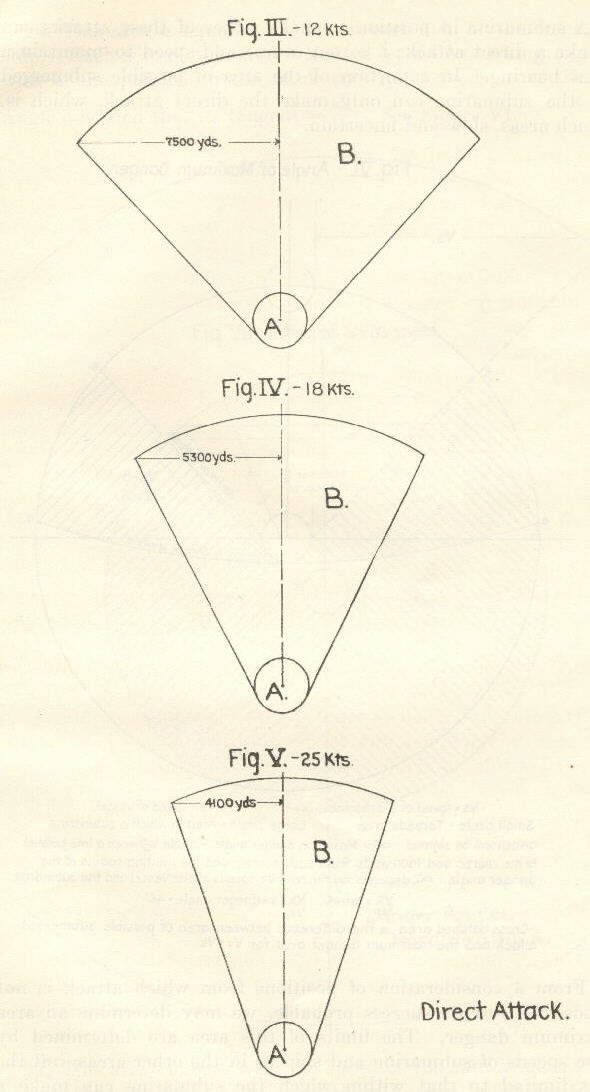
--- 11 ---
26. A submarine in position to make either of these attacks can also make a direct attack; i.e., set course and speed to maintain a constant bearing. In a portion of the area of possible submerged attack the submarine can only make the direct attack, which is, from such areas, slow and uncertain.
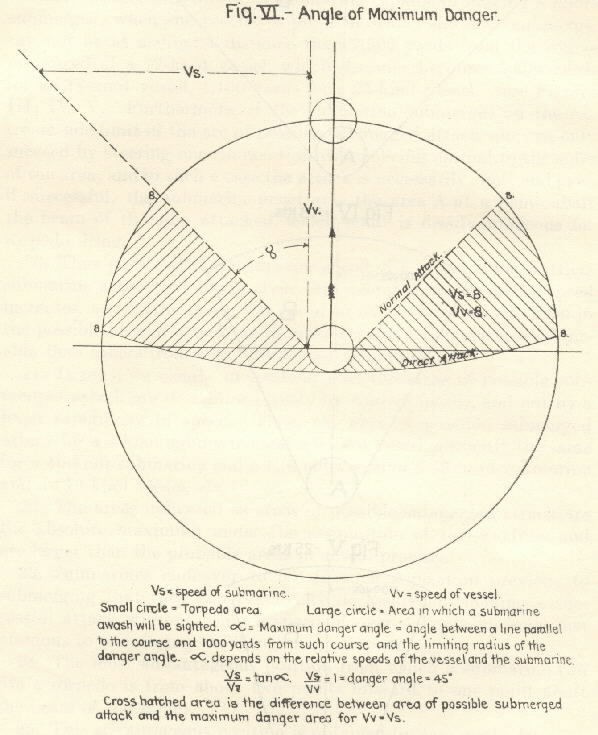
27. From a consideration of positions from which attack is not only possible, but its success probable, we may determine an area of maximum danger. The limits of this area are determined by relative speeds of submarine and ship as in the other areas, but the area is limited to that within which the submarine can make a normal attack using its full submerged speed.
--- 12 ---
28. This area is equally divided on each side of the track of the ship. Each side of this area is limited by a line making an angle a with a line parallel to the track and 1,000 yards from the track.
Angle a is such that its tangent = Vs/Vv. See Figure VI.
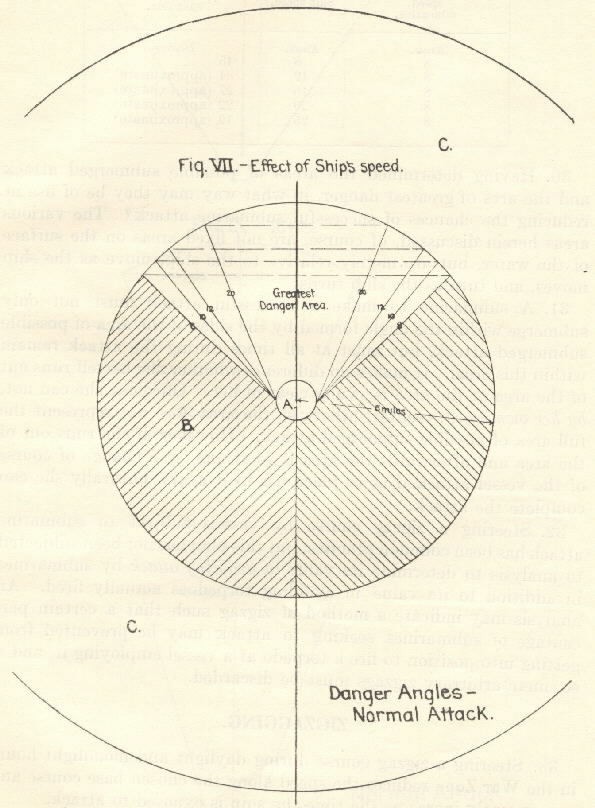
29. This area changes with the speed of the ship as does the area of possible submerged attack and the change is indicated in Figure VII. The relative size of the areas is represented in Figures VIII,
--- 13 ---
IX, and X. The angles obtained from the formulas above may be considered approximately equal to one-half arc of greatest danger. By calculation these arcs are approximately as follows:
| Submerged Speed, submarine. |
Ship speed. | Danger arc on each side. |
| Knots. | Knots. | Degrees. |
| 8 | 8 | 45 |
| 8 | 12 | 34 (approximate) |
| 8 | 16 | 27 (approximate) |
| 8 | 20 | 22 (approximate) |
| 8 | 25 | 19 (approximate) |
30. Having determined the areas of possible submerged attack and the arcs of greatest danger, in what way may they be of use in reducing the chances of successful submarine attack? The various areas herein discussed, of course, are not fixed areas on the surface of the water, but are merely relative to the ship, move as the ship moves, and turn as the ship turns.
31. A submarine to make a successful attack must not only submerge within the angle formed by the sides of the area of possible submerged attack, but must at all times during the attack remain within this area. It makes no difference whether she herself runs out of the area or the area is swung clear of her. Once out she can not, by her own speed, reenter; otherwise the area does not represent the full area of possible submerged attack. However, if she runs out of the area and afterwards the area is so swung by a change of course of the vessel attacked as to place her in it again, naturally she can complete the attack.
32. Steering a zigzag course by vessels subject to submarine attack has been common practice, but this plan has not been subjected to analysis to determine its value in avoiding attack by submarines in addition to its value in avoiding torpedoes actually fired. An analysis may indicate a method of zigzag such that a certain percentage of submarines seeking to attack may be prevented from getting into position to fire a torpedo at a vessel employing it, and if so, mere arbitrary zigzags must be discarded.
ZIGZAGGING.
33. Steering a zigzag course during daylight and moonlight hours in the War Zone reduces the speed along the chosen base course and consequently increases the time the ship is exposed to attack.
34. Unless, therefore, it can be proven that steering a zigzag course is advantageous to such a degree as to overcome the above disadvantage, the use of such zigzag courses should be stopped.
--- 14 ---
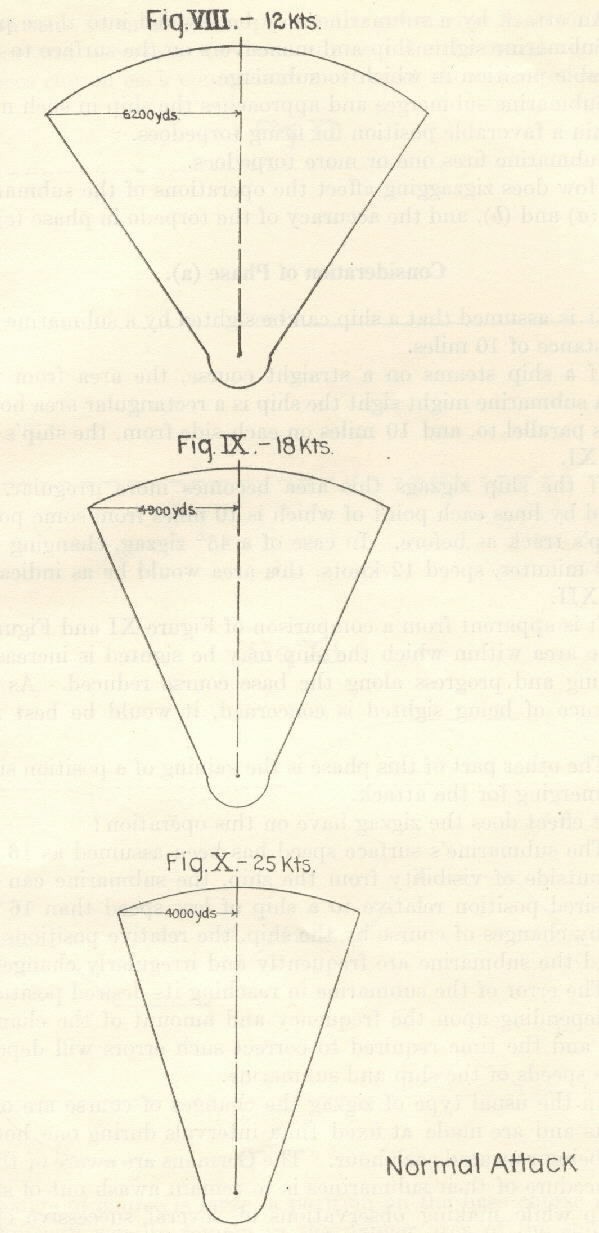
--- 15 ---
35. An attack by a submarine may be divided into three phases:
(a) Submarine sights ship and maneuvers on the surface to obtain a favorable position in which to submerge.
(b) Submarine submerges and approaches the ship in such manner as to gain a favorable position for firing torpedoes.
(c) Submarine fires one or more torpedoes.
36. How does zigzagging affect the operations of the submarine in phases (a) and (b), and the accuracy of the torpedo in phase (c)?
Consideration of Phase (a).
37. It is assumed that a ship can be sighted by a submarine awash at a distance of 10 miles.
38. If a ship steams on a straight course, the area from within which a submarine might sight the ship is a rectangular area bounded by lines parallel to, and 10 miles on each side from, the ship's track. Figure XI.
39. If the ship zigzags this area becomes more irregular, being bounded by lines each point of which is 10 miles from some point on the ship's track as before. In case of a 45° zigzag, changing course each 30 minutes, speed 12 knots, this area would be as indicated in Figure XII.
40. It is apparent from a comparison of Figure XI and Figure XII that the area within which the ship may be sighted is increased by zigzagging and progress along the base course reduced. As far as the chance of being sighted is concerned, it would be best not to zigzag.
41. The other part of this phase is the gaining of a position suitable for submerging for the attack.
What effect does the zigzag have on this operation?
42. The submarine's surface speed has been assumed as 16 knots. While outside of visibility from the ship, the submarine can attain any desired position relative to a ship of less speed than 16 knots, unless by changes of course by the ship, the relative positions of the ship and the submarine are frequently and irregularly changed.
43. The error of the submarine in reaching its desired position will vary, depending upon the frequency and amount of the changes of course, and the time required to correct such errors will depend on relative speeds of the ship and submarine.
44. In the usual type of zigzag the changes of course are of fixed amounts and are made at fixed time intervals during one hour, the zigzag being repeated each hour. The Germans are aware of this and the procedure of their submarines is to remain awash out of sight of the ship while making observations of several successive changes of course, noting the time, direction, and angle of changes. These
--- 16 ---
observations, in most cases, permit the submarine to predict future changes and ascertain the base course. In the usual zigzags the distances run on each course is in most cases short, and even though
![[Top] Figure XI - showing straight course and 10 miles visibility on each side and [Bottom] Figure XII - showing zigzag course and 10 miles visibility on each side. [Top] Figure XI - showing straight course and 10 miles visibility on each side and [Bottom] Figure XII - showing zigzag course and 10 miles visibility on each side.](/content/history/nhhc/research/library/online-reading-room/title-list-alphabetically/a/analysis-advantage-speed-changes-course-avoiding-attack-submarine/_jcr_content/body/image_6.img.jpg/1424723314824.jpg)
the change of course is large, a position on the base course ahead of the ship will usually remain in the danger area of the ship during the zigzags. See Figure XIII.
--- 17 ---
![[Top] Figure XIII - showing typical zigzag. Covers 1 hour. On base course at beginning of each hour and [Bottom] Figure XIV showing present type of zigzag, Nav. factor = 89, duplicated hourly with proposed type of zigzag, Nav. factor = 86, diagram covers 7 hours. [Top] Figure XIII - showing typical zigzag. Covers 1 hour. On base course at beginning of each hour and [Bottom] Figure XIV showing present type of zigzag, Nav. factor = 89, duplicated hourly with proposed type of zigzag, Nav. factor = 86, diagram covers 7 hours.](/content/history/nhhc/research/library/online-reading-room/title-list-alphabetically/a/analysis-advantage-speed-changes-course-avoiding-attack-submarine/_jcr_content/body/image_7.img.jpg/1424723385773.jpg)
--- 18 ---
45. In order to gain any advantage in avoiding attack by the submarine; it is necessary that the zigzag shall be such that observation of several changes of course shall not permit the submarine to predict future changes.
46. Considering only this phase, the frequency and amount of change by ships of less than 16 knots speed should be such as to cause the greatest amount of uncertainty in predicting the mean course for the succeeding run of one or two hours. Vessels of 16 knots or over should use the minimum zigzag consistent with its purpose in order to maintain their advance nearly equal or superior to the surface speed of the submarine.
47. In all cases the changes of course should be at irregular intervals and of irregular amounts. The practice of duplicating a zigzag each hour or even each two or three hours, should be discontinued as should the practice of equalizing the amount steamed on each side of the base course each hour. No base course, as such, should exist, unless as a general guide in indicating relative courses. A zigzag started at daylight should be laid out for the entire daylight and the navigational data--course and distance made good determined for any desired instant from the diagram.
48. Figure XIV shows two zigzags, the navigational factors of which are for the period of seven hours approximately the same. The lower one is designed to reach the given position at the end of the period and to create the greatest difficulty in predicting the future course of the ship. The upper zigzag is of the present type. The regularity of the present type of zigzag can not help but be of assistance to the attacking submarine. This subject is discussed in greater detail in the following paragraphs.
49. Considering only the phase in which the submarine is attempting to gain a proper position in which to submerge, it might be advantageous to continue each leg of the zigzag for a long period of time, trusting that the submarine will not attack until at least three changes have been made. The infrequency of the changes of course may, however, become apparent and then the submarine may attack without waiting to estimate the future changes; in this case, and in the next phase, the submerged attack, long periods on one course are advantageous to the submarine.
The Submerged Attack Phase (b).
50. We have assumed that the submarine will be visible, if awash, at a distance of 5 miles, or, in other words, that the submarine will submerge for its attack at a distance from the ship of not less than 5 miles.
51. Considering the areas of possible submerged attack, Figures III, IV, and V, and the greatest danger areas, it is apparent that if
--- 19 ---
the relative speeds are, ship 12, submarine 8, there are certain areas within 5 miles of the ship from which the submarine can not attack; in the other portions an attack can be delivered from the 5-mile circle in an interval of time depending upon the speed of the ship and submarine and upon the position from which the submarine is making its attack.
![Figure XV - [Speeds: Ship - 12 knots, submarine - 8 knots (submerged); Time required from maximum danger arc limit = 19.7 minutes; Time required from ahead = 13.5 min.; Average time = 16.6 min.] Figure XV - [Speeds: Ship - 12 knots, submarine - 8 knots (submerged); Time required from maximum danger arc limit = 19.7 minutes; Time required from ahead = 13.5 min.; Average time = 16.6 min.]](/content/history/nhhc/research/library/online-reading-room/title-list-alphabetically/a/analysis-advantage-speed-changes-course-avoiding-attack-submarine/_jcr_content/body/image_8.img.jpg/1424723535829.jpg)
52. Assuming speed of ship 12 knots and submarine 8 knots, from directly ahead the submarine could reach the circle 1,000 yards from the ship in about 13.5 minutes. See Figure XV.
53. A normal attack could be delivered from the limiting position in 19.7 minutes. The direct attack from the limiting position would require about 32 minutes.
--- 20 ---
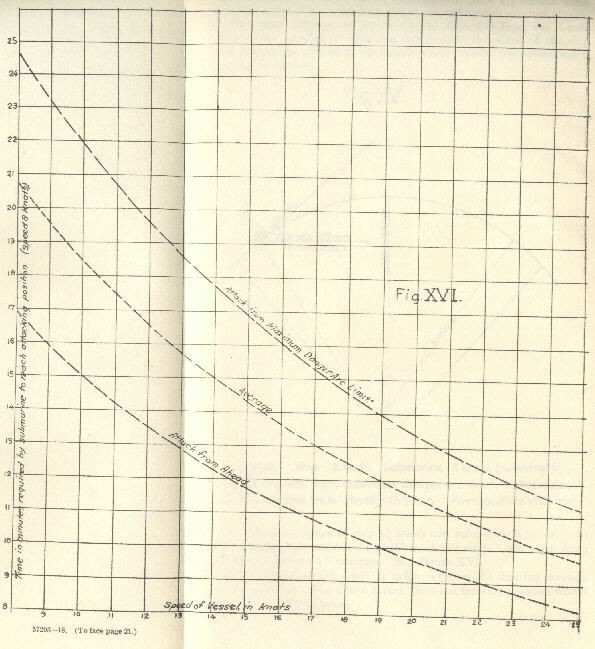
[Insert - no page number]
54. Considering only the direct attack from ahead, and the normal attack, the average time is 16.6 minutes. In order, therefore, to have a sure chance of changing the course at least once while the submarine is making its attack, it would be necessary to change course at intervals not in excess of 13.5 minutes. The time is probably greater in practice. The time on one course may, therefore, without much decrease in efficiency, occasionally be extended to 20 minutes:
55. In order that the time on each course may be variable, it is desirable to vary the time steamed on the various courses between 10 and 20 minutes for a ship whose speed is 12 knots.
56. These time intervals vary with the relative speeds of the ship and submarine and also with their actual speeds. The curves in the following diagram (see Fig. XVI) indicate -
(a) Time required for a direct attack from ahead.
(b) Time of normal attack from limiting position.
(c) Average of these time intervals.
It will be seen from the above that the frequency with which changes of course should be made in order to be certain that at least one change is made after the submarine submerges and before the attack is complete can be determined more or less exactly. See Figure XV, page 20.
57. The effect of this change of course is to change the data upon which the submarine is basing its calculations for the attack. The change of course may be such as to throw the submarine into a zone from which it is not dangerous to the ship. It may be such as to approach the submarine more rapidly, and may thus prevent the submarine from making a well-directed shot, or it may cause the submarine to dive to avoid being rammed.
58. On the other hand, it is possible that a submarine which had misjudged his position might be aided by this change of course by the danger area being swung in such a way as to include its position. This chance must be accepted on the ground that few submarine commanders will make this error compared to the number of instances in which such change of course will be advantageous, and the change is almost sure to disturb the enemy's calculations, thus requiring a hasty readjustment of plan with consequent confusion on his part. Large changes of course are, as will be shown later, disadvantageous because of the increase in the danger area caused thereby and the reduction in virtual speed in the danger zone.
--- 21 ---
DISCUSSION OF THE CHANGE IN DANGER AREAS DUE TO ZIGZAGGING.
59. It has been shown:
(a) That zigzagging increases the chance of being sighted by a submarine, and
(b) That the zigzag increases the time during which the ship is in the danger zone.
60. By an examination of the danger areas it has been determined that a ship should, in order to be sure that the data upon which the submarine is basing its attack shall be changed at least once during the attack, change course at intervals of time which should not greatly exceed the ordinate (shown in minutes) of the point on the middle curve of Figure XVI, facing page 21, corresponding to the speed of the vessel.
61. There still remains to be considered the effect on the danger areas,
(a) of the extent of the changes in course,
(b) of the length of time steamed on each course.
62. (a) In Figure XVII the point A in each case is the position of the vessel at the time the submarine submerges. If the vessel continued on the course A E she could be successfully attacked by a submarine lying, at the time the ship was at A, anywhere in the area BCA'. If upon reaching E the vessel is to change course and head for F, a certain portion of this area is eliminated as a danger area because the submarine to attack at E must have been within a distance eight-twelfths of AE at the time the vessel was at A. A circle about E with a radius eight-twelfths of AE is the limit of the danger area for an attack at E. The crosshatched area X is the area eliminated as a part of the danger area by the change of course at E. A submarine within the dotted area of the lower figure could attack at some point on the line EF if the change of course is to be but 20°, as indicated in the lower figure.
(b) This change of course, however, makes possible an attack by a submarine whose position when the vessel was at A, lay within the crosshatched area Y. Now, had the course not been changed, a submarine in this area could not have attacked.
(c) The relative sizes of the areas X and Y indicate the increase in the danger area due to change of course. It is seen from the diagrams that the area eliminated as dangerous and the increase in the danger area just about balance for a change of course of 20° by a 12-knot vessel, while for a large change like 75° the increase in danger area is quite marked.
63. These diagrams show that to avoid a submarine whose position is unknown by making large changes of course is impracticable. Large changes of course increase the danger area.
--- 22 ---
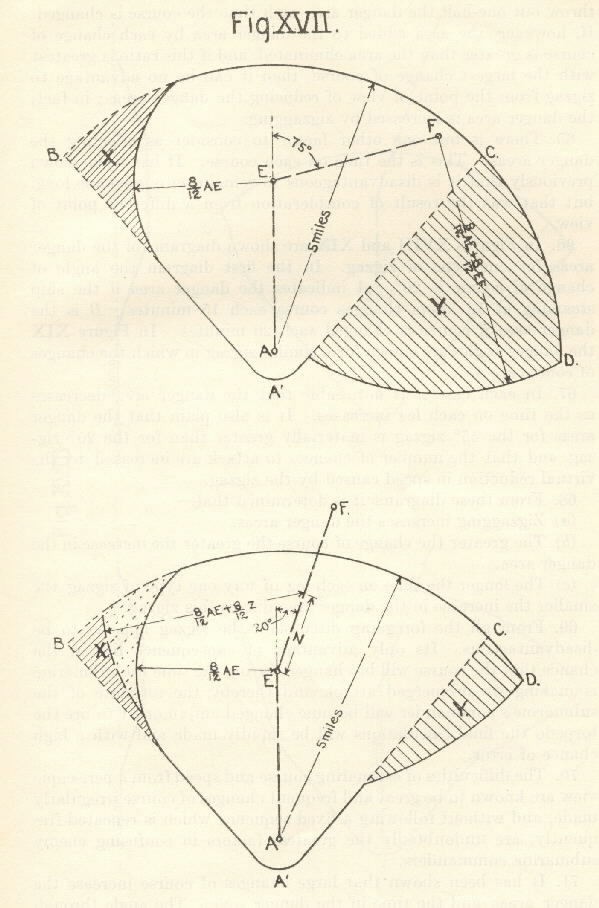
--- 23 ---
64. It has been suggested that the zigzag should be such as to throw out one-half the danger area each time the course is changed. If, however, the area added to the danger area by each change of course is greater than the area eliminated, and if this ratio is greatest with the largest change of course, then it can be no advantage to zigzag from the point of view of reducing the danger areas; in fact, the danger area is increased by zigzagging.
65. There is but one other factor to consider as affecting the danger areas. This is the time on each course. It has been shown previously that it is disadvantageous to remain on one course long, but that was the result of consideration from a different point of view.
66. In Figures XVIII and XIX are shown diagrams of the danger areas for one type of zigzag. In the first diagram the angle of change of course is 20°. A indicates the danger area if the ship steaming at 12 knots changes course each 15 minutes. B is the danger area if course is changed each 20 minutes. In Figure XIX the danger angles are shown for a similar zigzag in which the changes of course are 45°.
67. In each case it is noticeable that the danger area decreases as the time on each leg increases. It is also plain that the danger areas for the 45° zigzag is materially greater than for the 20° zigzag, and that the number of chances to attack are increased by the virtual reduction in speed caused by the zigzag.
68. From these diagrams it is determined that-
(a) Zigzagging increases the danger areas.
(b) The greater the change of course the greater the increase in the danger area.
(c) The longer the time on each leg of any one type of zigzag the smaller the increase in the danger area due to this zigzag.
69. From all the foregoing discussion, the zigzag appears to be disadvantageous. Its only advantage of consequence lies in the chance that the course will be changed during the time the submarine is making its submerged attack and thereby the estimate of the submarine's commander will become changed and in order to fire the torpedo the final calculations will be rapidly made and with a high chance of error.
70. The difficulties of estimating course and speed from a periscopic view are known to be great and frequent changes of course irregularly made, and without following a fixed sequence which is repeated frequently, are undoubtedly the greatest factors in confusing enemy submarine commanders.
71. It has been shown that large changes of course increase the danger areas and the time in the danger zone. The angle through which the course is to be changed should therefore be reduced to as
--- 24 ---
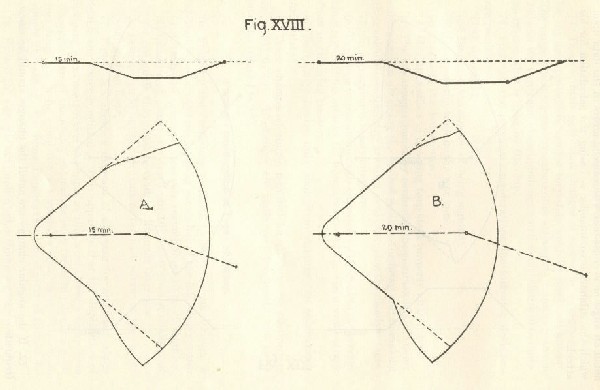
--- 25 ---
small an angle as is consistent with causing errors in the data upon which the submarine commander is basing the calculation for his attack.
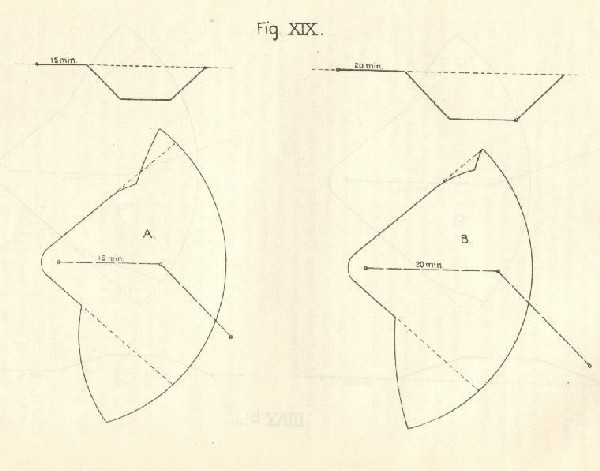
72. If the angular changes are small the changes should be more frequent.
--- 26 ---
Consideration of Phase (c).
73. There is little hope that changes of course in zigzagging will be any real protection against torpedoes actually fired and unseen. The range which the enemy submarines attempt to reach is between 250 and 400 yards and at such distance a well-aimed shot will not miss no matter what is done by the ship.
74. From all the previous considerations the following decisions are reached:
That zigzagging -
(a) Increases the chance of being sighted;
(b) Increases the time in the war zone;
(c) Increases the danger area;
(d) Has little effect in avoiding torpedoes properly aimed; but
(e) The advantages gained by confusing the commanders of enemy submarines in obtaining the desired position for firing and in making their calculations for firing are such as to overcome the disadvantages.
75. In zigzagging it is advantageous--
(a) To change course at intervals approximately equal to the average time required for attacks (a) from ahead--(b) for the normal attack from the limiting position.
(b) To change course only enough to confuse the submarine's firing data.
(c) These changes of course required for (b) may be assumed as from 20° to 40°. If changes are made very frequently, the angle may be reduced to 10°.
Further Consideration of Types of Zigzag.
76. Fulfilling the conditions required by the previous decision, a 12-knot-vessel should use a zigzag somewhat of the following nature:
(a) Changes of course at intervals varying from 10 to 20 minutes.
(b) Changes of course varying from 10° to 40°; when changes of course are small, they must be made at frequent intervals.
(c) Course should not be the same as the base course at the end or beginning of an hour.
77. Figure XX shows a diagram of a zigzag for one hour which fulfills the above conditions. It is apparent that the duplication of a zigzag of a construction as simple as this would hardly complicate the operations of the enemy submarine in so far as obtaining a position from which he could fire a torpedo is concerned. The more simple the zigzag, the more important it is that it shall not be duplicated.
78. Even if the zigzag is not duplicated, a simple zigzag constructed upon the same base course for two or more successive hours can not be a serious detriment to the enemy submarine as far as reaching a
--- 27 ---
firing position is concerned, because the maximum displacement from the base course will never be such as to avoid a submarine which at any time attains a position on the base course.
79. In order then to reduce the chance of the enemy predicting future changes of course, or even a prediction as to the base course, it is desirable to make the zigzag extend without duplication over a long period of time, preferably at least one-half of the hours during which it is contemplated zigzagging on any one day, and the zigzag to be such that the apparent base course changes at intervals varying from about 40 minutes to 1 hour 20 minutes. The effect of this will be to confuse the enemy submarine as to the base course and as to
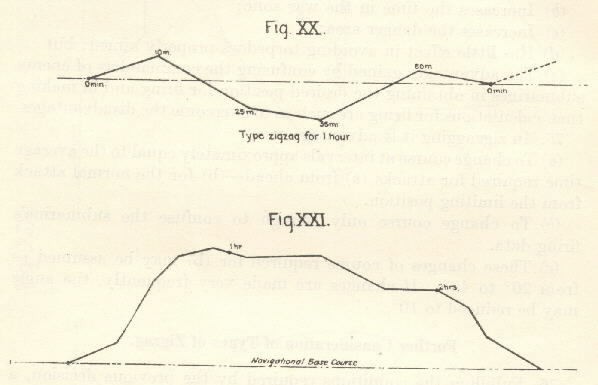
future changes of course. Figure XXI indicates the track of a vessel for 2 hours 40 minutes of such a zigzag.
80. The navigational factor will be reduced somewhat by the wide departure from the base course, but the difficulties encountered by the enemy in predicting future changes of course, or the base course upon which the zigzag is constructed, will be so increased as to warrant the reduction in virtual speed imposed.
Construction of Zigzags with Regard to Sun, Wind, and Sea.
81. Additional factors which play an important part in successful submarine attacks are the conditions of sun glare, light, wind, and sea. A few rules which submarines are supposed to follow and which observations have confirmed are given to indicate the importance of the consideration of these factors in zigzagging.
--- 28 ---
![Figure XXII - [Zigzag for 11 hours and 30 minutes. Twilight 4:00 A.M., Course toward bright horizon. Navigation factor = 78.] Figure XXII - [Zigzag for 11 hours and 30 minutes. Twilight 4:00 A.M., Course toward bright horizon. Navigation factor = 78.]](/content/history/nhhc/research/library/online-reading-room/title-list-alphabetically/a/analysis-advantage-speed-changes-course-avoiding-attack-submarine/_jcr_content/body/image_14.img.jpg/1424724446120.jpg)
--- 29 ---
ANALYSIS OF LIGHT, WIND, AND SEA CONDITIONS.
82. SUN GLARE. -
RULE: When choice is possible, a submarine will attack from the direction toward the sun.
REASON: (a) If the periscope is shown with caution (i.e., frequently, but only for a short time and but a few inches of it exposed) it can not be seen by any possible means when it is in water in which the sun is reflected directly toward the ship. Even the track of bubbles will probably not be seen until it is too late to avoid the torpedo. (b) In an attack toward the sun the glare dazzles a periscope operator, making it difficult to judge the course, speed, or distance of the ship. The ship appears as a black silhouette and the bow wave and wake completely vanish in the glittering water.
MEANS TO AVOID GIVING SUBMARINES THIS ADVANTAGE: Course should be such that the bearing of the sun is not within the danger angle, especially when the sun is low.
83. LIGHT CONDITIONS. -
RULE: Attacks at night in smooth water from awash or surface condition have proven effective. Clear twilight offers very favorable light conditions for shots from the submerged condition.
REASON: With a favorable background (with reference to clouds and moon) a submarine can approach on the surface to within 500 yards without being sighted. Under these conditions a ship would probably be visible 1,000 to 1,500 yards.
In twilight attacks a submarine will endeavor to attack on the side away from the bright background.
MEANS TO AVOID SUBMARINE: At night the course should be toward the moon. At morning and evening twilight a ship should steer so that the light background covers the danger angle. When in cloudy weather, light conditions during the day approach to normal twilight conditions, the same remarks apply.
84. WIND CONDITIONS. -
RULE: In a strong breeze a submarine will attack from windward if possible.
REASON: (a) The periscope moving with the wind and sea make very little commotion in the water. A periscope moving to windward will cause a large amount of spray even when moving at the slowest speed. (b) A lookout to windward is very much more difficult to maintain than one to leeward, especially if rain or snow accompanies the wind.
MEANS TO AVOID SUBMARINE: It is advantageous to have a strong wind abaft the beam. Lookouts to windward should be increased and frequently relieved.
--- 30 ---
RULE: In a light breeze a submarine may attack from either windward or leeward side. If the attack is from windward, a torpedo fired is probably a bow shot. If from the leeward, it probably is a stern shot.
REASON: In a light breeze the submarine will travel with the wind and sea, therefore, from windward it will use its bow tubes; from leeward, its stern tube.
METHOD TO AVOID ATTACK: Keep the wind and sea abaft the beam if possible.
85. STRENGTH OF WIND AND SEA. -
RULE: A submarine will seldom fire a torpedo when the sea is dead calm.
REASON: In a calm sea a periscope will generally be sighted before the submarine reaches firing range, and if the torpedo is fired it can be seen sufficiently early to be avoided in most cases.
RULE: Force of wind 3-4 and a whitecap sea present the most favorable conditions for submarine attack.
REASON: (a) The sea just washes over the periscope if the latter is shown sparingly, and, without masking the view from the periscope, makes it difficult for the ship to recognize the periscope. (b) At any considerable distance the periscope feather can not be distinguished from the small breaking seas. (c) The submarine is easily kept at the proper depth for the attack. (d) The torpedo is not apt to broach.
RULE: If the wind is 5-6 and the sea moderately rough, it will be difficult for the submarine to fire. If she does, the torpedo will probably come from a direction parallel to the trough of the sea.
REASON: From any other direction it is difficult to reach firing range without exposing the conning tower or at least a large portion of the periscope. The torpedo is apt to broach unless fired in the trough of the sea also its propellers may break the surface and give away its position.
80. CONCLUSIONS REGARDING LIGHT, WIND, AND SEA CONDITIONS.--For the submarine the most favorable light conditions for an attack are: (a) From the direction of a bright sun glare; (b) in clear twilight from the direction of the dark background--preferably morning twilight.
The most favorable wind conditions: (a) Breeze 3-4, the attack from windward.
The most favorable sea conditions: (a) A light white capped sea.
To avoid giving the submarines these favorable conditions a ship should: (a) Avoid steaming on such a course that the bearing of the sun will lie within the danger angle; (b) when possible, steam with the sea; (c) at twilight, steam toward the brightest part of the horizon.
--- 31 ---
81. Considering all the points covered in the discussion of speed, changes of course, and weather and visibility conditions, the following conclusions are reached:
(a) Every endeavor should be made to increase the speed of all vessels when passing through the danger zone.
(b) The most important increase in speed is that at about the submerged speed of the submarine; i.e., 7 to 9 knots.
(c) Zigzagging is in some respects disadvantageous, in that the chances of being sighted are increased and the danger areas increased.
(d) The advantages of zigzagging, due to the interference with the submarine's calculations for reaching position desired for the attack and for firing, outweigh the disadvantages.
(e) In zigzagging large changes of course are disadvantageous as by making such the danger area is increased and the time within the danger zone increased.
(f) That changes of course should be made at irregular time intervals, which should not be much less than the time required for a direct attack from ahead or much more than the time required for the normal attack from the limiting position. For speed of ship 12, and submerged speed of submarine, these times are, minimum 10 minutes, maximum 20 minutes.
(g) That the changes of course must be sufficiently large to cause a material error in the calculations of the submarine's commander. The angle required should not be less than 20° or over 40°, except that if changes are made, at intervals of time not greater than one-half the maximum time interval for the speed in use, 10° changes may be made.
(h) That in view of the possibility that a submarine may be able to predict changes in courses and to determine the base course from a series of several observations when the zigzag is duplicated each hour, this practice should be abolished and the zigzag so constructed that no two successive hours are similar.
(i) In order to make the determination of the base course impossible, the zigzag should extend over a period of at least half a day, the apparent base course being changed at intervals varying from 40 minutes to 1 hour 20 minutes.
(j) In constructing zigzag diagrams, possible conditions of sun glare, prevailing wind, and position of light areas during twilight should be considered, and the zigzag selected so as to afford the greatest advantage with regard to light, wind, and sea conditions.
--- 32 ---
[END]



